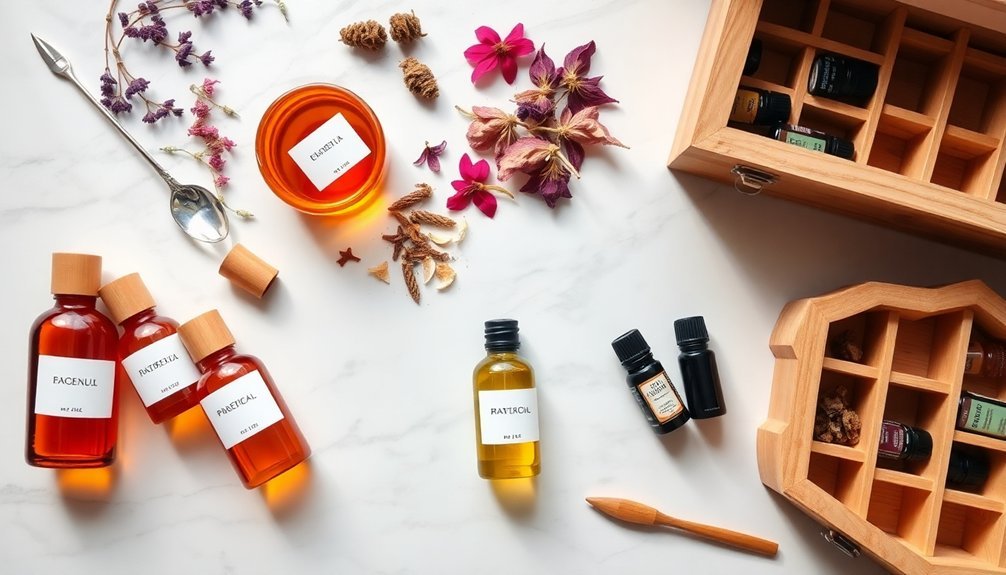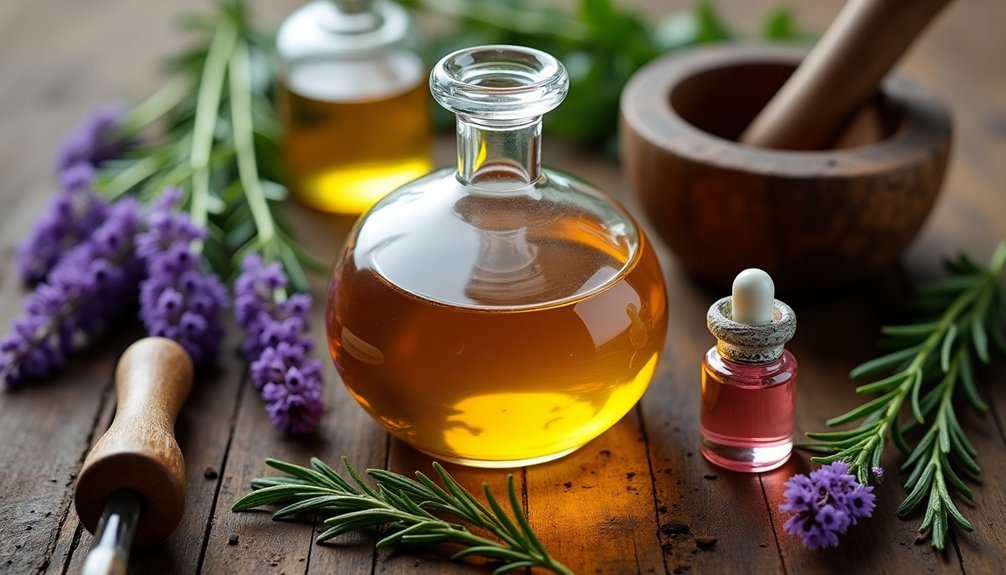You'll need five essential tools to start making natural perfumes like a pro. Begin with dark glass bottles to protect your ingredients, and invest in precise measuring equipment like pipettes and a digital scale. Add borosilicate glass beakers for mixing, pH strips for testing stability, and proper safety gear including nitrile gloves and safety goggles. These fundamentals will set you up for success as you explore the aromatic world of natural perfumery.
Essential Storage Solutions for Your Natural Perfume Ingredients

Proper storage is essential for maintaining the quality and potency of your natural perfume ingredients. You'll need dark glass bottles in various sizes to protect your oils from light damage and oxidation. Choose containers that match your oil quantities to minimize air exposure, and always make certain they're tightly sealed. Consider keeping a record of dates for all your stored ingredients.
Store your ingredients in a cool, dark place away from sunlight and humidity. A dedicated drawer or closet shelf works perfectly, as long as it's away from heat sources and temperature fluctuations.
When handling your oils, use clean stainless steel tools and funnels to transfer them between containers. Label everything clearly to avoid confusion.
Don't forget to regularly inspect your stored oils for signs of deterioration and keep your storage area clean and free from potential contaminants.
Precision Measuring Tools for Perfect Blending
When creating natural perfumes, accurate measurements can make the difference between a signature scent and a failed blend. You'll need glass measuring cylinders and beakers for precise mixing of oils, along with graduated columns for smaller quantities. Don't forget your digital scale for exact weight measurements. Always ensure to wash equipment with soapy water to maintain cleanliness.
| Tool Type | Primary Use | Key Feature |
|---|---|---|
| Pipettes | Oil Transfer | Drop Control |
| Thermometers | Temperature Check | Recipe Compliance |
| Digital Scale | Weight Measurement | Precision Control |
For the most precise measurements, use disposable plastic pipettes for transferring small amounts of oils, and keep multiple on hand to avoid cross-contamination. You'll also want to maintain proper temperature control using accurate thermometers, especially when working with temperature-sensitive ingredients. Remember to sterilize all your equipment with ethanol before use to guarantee the purity of your blend.
Glass Equipment for Safe and Pure Perfume Making

High-quality glass equipment forms the backbone of safe and pure perfume making.
You'll need borosilicate glass beakers for mixing ingredients and amber glass bottles for storing your finished blends. Glass funnels and pipettes are essential for filtering and precise measurements, as plastic alternatives can dissolve when exposed to essential oils. Commercial Wattman filter paper helps remove unwanted particles when filtering your perfumes.
When setting up your perfume-making station, prioritize these critical glass items:
- Borosilicate beakers with graduated markings for accurate measuring and mixing
- Amber glass bottles to protect your perfumes from sunlight degradation
- Glass pipettes (at least 50) and funnels for contamination-free transfers and filtering
Each piece of glass equipment serves a specific purpose in maintaining the purity and quality of your natural perfumes, ensuring your creations remain stable and fresh.
Testing and Evaluation Materials for Quality Control
Testing your natural perfumes requires specific materials and tools to guarantee consistent quality and safety. You'll need pH strips, glass test tubes, and sample vials for conducting stability tests at different temperatures and light conditions. Don't forget to invest in patch test materials and documentation tools to record allergen findings.
| Testing Type | Essential Tools | Purpose |
|---|---|---|
| Quality | GC-MS analyzer | Verify ingredient authenticity |
| Stability | Glass test tubes | Monitor temperature changes |
| Safety | Patch test strips | Check for skin reactions |
| Sensory | Scent strips | Evaluate fragrance profile |
| Documentation | Lab notebook | Record test results |
For sensory evaluation, you'll want perfume testing strips, neutral-scented cleaning wipes, and a timer to track the development of your scent. Keep detailed records of all test results using a dedicated lab notebook and digital backup system.
Safety and Sterilization Equipment for Professional Results

Once you've established your testing protocols, outfitting your workspace with proper safety and sterilization equipment becomes your next priority.
You'll need essential PPE including nitrile gloves, safety goggles, and lab coats to protect yourself while handling ingredients. A well-ventilated workspace with fume hoods is vital when working with volatile substances.
Your basic safety setup should include:
- Emergency eye wash stations and safety showers that meet EN and ANSI standards
- UV sterilization units for sanitizing bottles and equipment
- Stainless steel trays to contain spills and protect work surfaces
Don't forget to maintain proper skin care and hygiene practices after handling materials.
Keep your workspace clean and organized, and regularly inspect your safety equipment to guarantee it's functioning correctly.
Frequently Asked Questions
How Long Does Homemade Natural Perfume Typically Last Before Expiring?
Your homemade natural perfume will typically last 1-2 years if it's citrus-based, or up to 8 years for woody scents. You'll get the best shelf life by storing it properly in dark, cool conditions.
What's the Best Room Temperature for Blending Natural Perfumes?
You'll achieve the best blending results when your room temperature stays between 15°C to 25°C (59°F to 77°F). This range helps maintain oil stability and prevents excessive evaporation of delicate fragrance notes.
Can I Use Plastic Droppers Instead of Glass Ones?
You shouldn't use plastic droppers because they'll react with your perfume ingredients, altering the scent and contaminating your blend. Stick with glass droppers – they're chemically inert, reusable, and won't affect your fragrance's composition.
How Often Should Testing Strips Be Replaced During Perfume Making?
You'll need to replace testing strips after each fragrance evaluation to avoid cross-contamination. Don't reuse strips when testing different scents, and always use fresh ones to guarantee accurate assessment of your perfume blends.
What's the Minimum Investment Needed to Start Making Natural Perfumes?
You'll need at least $13,000 to get started with natural perfumes. This covers essential oils, basic equipment, storage containers, and your living expenses while you develop and launch your first product line.
In Summary
Now you're equipped with the essential tools to start your natural perfume-making journey. Keep your materials organized, measure with precision, use clean glass containers, test thoroughly, and maintain proper safety protocols. With these five must-have tools at your disposal, you'll create pure, professional-quality fragrances from natural ingredients. Don't forget to document your blending ratios for consistent results in future batches.





Leave a Reply